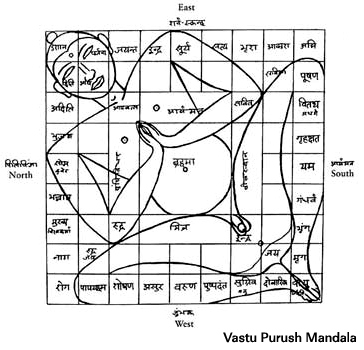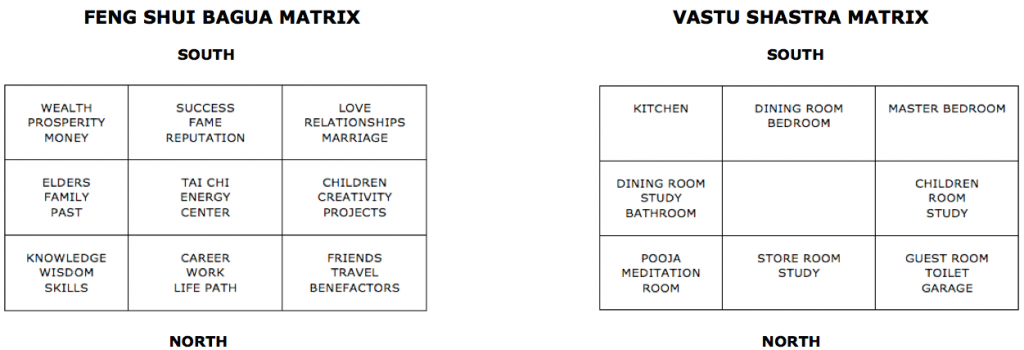Introduction:
In the world of architectural harmony and spiritual design, two ancient practices stand out for their influence and uniqueness: feng shui and Vastu Shastra. While both originate from ancient Eastern traditions – feng shui from China and Vastu Shastra from India – they offer distinct perspectives and methodologies in creating balanced living spaces. This blog delves into the nuances, similarities, and differences between these two venerable systems.
Feng Shui: The Chinese Art of Harmony
Feng shui is an ancient Chinese art that focuses on harmonizing individuals with their surrounding environment. It is grounded in Taoist principles and the concept of ‘qi’ or ‘chi’ – the life force or energy flow. feng shui practitioners use various tools and principles, like the Bagua map and the five elements (wood, fire, earth, metal, and water), to optimize the flow of this energy in living and working spaces.
Vastu Shastra: India’s Science of Architecture
Vastu Shastra, often termed the ‘science of architecture’, is an ancient Indian system of design based on directional alignments. It is rooted in the Vedas, the comprehensive scriptures of Hinduism, and focuses on integrating architecture with nature, using geometric patterns (yantras), symmetry, and directional alignments. Vastu aims to create spaces that align with the fundamental forces of nature.
Similarities Between feng shui and Vastu Shastra
Holistic Approach: Both systems take a holistic approach to design, emphasising the importance of living in harmony with the environment.
Energy Flow: Each practice focuses on the flow of energy – ‘qi’ in feng shui and ‘Prana’ in Vastu Shastra – and its influence on well-being.
Five Elements: Both incorporate the concept of the five elements, although they are defined differently in each system.
Spiritual Foundations: Each is deeply rooted in its respective spiritual and cultural traditions, offering more than just aesthetic guidelines – they provide a way of living.
Key Differences Between feng shui and Vastu Shastra
Cultural Origins: feng shui originates from China and is influenced by Taoist philosophies, while Vastu Shastra is derived from ancient Indian Vedic traditions.
Guiding Principles: feng shui uses the Bagua map to analyse and correct the flow of energy, focusing on the layout and orientation of spaces. Vastu Shastra relies more on cardinal directions and specific measurements for design and layout.
Flexibility vs. Rigidity: feng shui is generally more flexible, offering remedies and cures to adjust existing structures, while Vastu Shastra is often more rigid, emphasising specific dimensions and orientations from the beginning of a design.
Application Scope: While both can be applied to homes, offices, and gardens, Vastu Shastra also extends to town planning and larger architectural projects.
Conclusion
feng shui and Vastu Shastra, despite their differences, share a common goal: to enhance the quality of life through harmonious design. By understanding and respecting the principles of both, one can appreciate the depth and wisdom they bring to the spaces we inhabit. Whether through the flexible adaptation of feng shui or the precise guidelines of Vastu Shastra, both systems offer invaluable insights into the art of creating balanced and prosperous environments.
Book a vastu consultation
Integrating Both Practices in Modern Living
The Role of Compass Directions
A fundamental distinction lies in how each system views compass directions. In Vastu Shastra, each direction is ruled by a specific deity and planet, with the main entrance ideally facing north, east, or northeast for maximum benefit. feng shui, while also considering directions, uses the Bagua map to divide a space into specific areas that correspond to different aspects of life, such as wealth, health, or love.
The Concept of Time
Another interesting difference is the incorporation of time. feng shui includes the dimension of time in its analysis, with certain remedies and arrangements changing with the lunar year. Vastu Shastra, on the other hand, is more static, with principles that remain constant over time.
Interior and Exterior Elements
Both systems emphasise the importance of interior and exterior harmony, but they approach it differently. feng shui places significant emphasis on the arrangement of objects within a space, like furniture placement and colour choices. Vastu Shastra focuses more on the structural aspects, such as the location of doors, windows, and rooms.
Energy Correction Techniques
In feng shui, remedies such as mirrors, crystals, or water features are used to correct the energy flow. Vastu Shastra may suggest structural changes, like the addition or removal of rooms or changing the orientation of the house.
Integration in Contemporary Design
Modern architects and interior designers often integrate principles from both feng shui and Vastu Shastra, acknowledging their benefits in creating spaces that are not only aesthetically pleasing but also harmonious and energising. For instance, the use of natural light, open spaces, and the incorporation of natural elements can be seen as an amalgamation of both practices.
Personal and Cultural Interpretations
While both systems have their traditional roots, modern adaptations have seen a blending of these principles with personal and cultural interpretations. In the West, feng shui has been adapted to suit contemporary lifestyles, just as Vastu principles have been modified in modern Indian architecture.
The Universal Appeal of Harmonious Living
The growing interest in feng shui and Vastu Shastra worldwide is a testament to the universal human quest for balance, harmony, and connection with our environment. By understanding the underlying principles of these ancient wisdoms, we can create spaces that nurture and support us, both physically and spiritually.
Conclusion
In conclusion, while feng shui and Vastu Shastra have distinct origins and methodologies, their convergence lies in the shared goal of enhancing human well-being through environmental harmony. By appreciating both, we open ourselves to a world where space, energy, and design interplay gracefully, fostering environments that uplift and inspire. Whether one follows the flexible path of feng shui or the structured approach of Vastu Shastra, the journey towards creating more harmonious spaces is a rewarding one, filled with insights into the ancient wisdom that continues to guide us in the modern world.


